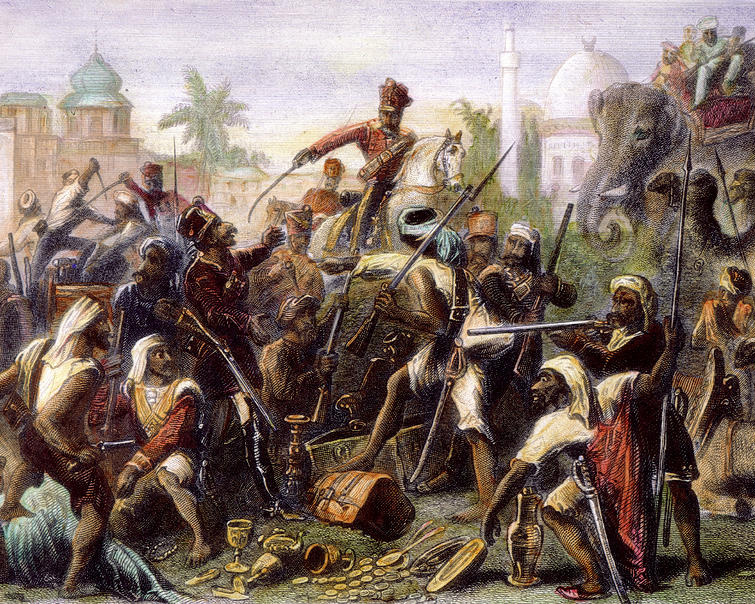
It is quite impossible to believe that some round and faultless chapatis, rotis, or the Indian flatbread that we eat almost every day, were a symbol of a massive movement that gave British officers a nightmare during the renowned Mutiny of 1857. The chapatis were a representation of a creative movement that had frightened the British officers with massive fury. However, nobody knows exactly where or how this movement initiated, but then it had countless British officers frightened and shocked.
Somewhere around February and March in 1857, thousands of perfect chapatis were distributed to houses across different regions in India by police chowkidars or constables at night. The people who accepted this exceptional offering started preparing more chapatis and continued this chain. And soon, a huge number of around 90,000 police constables joined in this, making the chapatis travel up to 300 km every night, which was even faster than the fastest British mail at that time. The secretive chapati movement of 1857 placed the British officers under massive pressure, and it converted into an operative defence of psychological warfare against the British rule.
Thousands of unmarked chapatis were distributed to houses and several police stations in the different regions of British India by some runners at night, and the people who were receiving it were oddly making more batches of chapatis to pass on, without any further instructions. As per some records, there were no words written or sings made on those chapatis, and the British officers were outraged at being unable to find grounds for arresting the chapati runners who were some of the police constables. All these chapatis were real, but all the people connected to it, not even the police constables, had any idea about what they were for. Quite strangely, when these chapati runners were later questioned by the British about the significance of carrying the chapatis from one home to another, they were absolutely clueless as to the purpose of their own actions.

Police offers during the British rule in India
The Chapati Movement was exposed by the Magistrate of the town of Mathura, Mark Thornhill. After this news was dispersed everywhere, he did a few investigations and found that chapatis were travelling up to 300 kilometers every night, everywhere from the river Narmada in the south to the border with Nepal, which was hundreds of miles to the north. This entire speedy distribution of the chapatis was enough to convince Mark Thornhill that some strange and suspicious was going on. Several wide-ranging inquiries were done to crack this matter, but the reason behind this strange event always remained a mystery. And the distribution of chapatis produced numerous theories and myths but very few facts.
In March 1857, Dr Gilbert Hadow, an army surgeon in the employ of East India Company, wrote some lines describing the Chapati Movement in 1857, in a letter to his sister in Britain. He wrote, “There is a most mysterious affair going on throughout the whole of India at present. No one seems to know the meaning of it. It is not known where it originated, by whom or by what purpose, whether it is supposed to be connected to any religious ceremony or whether it has to do with some secret society. The Indian papers are full of surmises as to what it means. It is called the chapati movement”. Even though there was no conclusive evidence, the puzzled British officers suspected that the chapatis were some kind of a code, indicating a call to an uprising against colonial rule of the British.

Source: commons.wikimedia.org
A scene from the Indian Mutiny of 1857
Numerous opinions were divided as to whether the chapati came from the Calcutta, or from Avadh in the north, or from Indore, in the center of the nation. Some recent studies have theorized that the movement of chapatis may have been an attempt to deliver food to people plagued with cholera at that time. However, in the face of questionable evidence, it can only be said for now that the chapatis were just some food items, and not some secret messages or warnings of some future revolts.
When the British noticed the rumours about some massive messaging through chapatis for revolt, they were terrified, and they directly started investigations. Quite a lot of speculations were made. However, even those who participated in it were uninformed of its origin and aims. Years later, J W Sherar in the book “life During the Indian Mutiny” acknowledged that if the aim behind the chapati movement was to create an atmosphere of secretive restlessness, the movement had been extremely effective. And we all should know that this movement was a notable example of how rumours go wild and terrify even the strongest armies. And yes, we should also recognize that our simple, healthy, and tasty chapati, once horrified our colonizers and placed them into a huge terror!
______________________________________
Reference:
- www.smithsonianmag.com
- www.web.archive.org
- www.wikipedia.org
